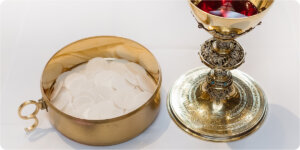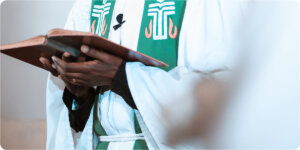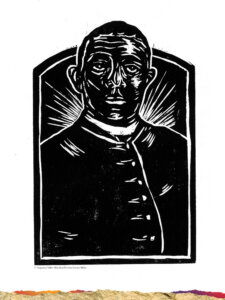The American Eucharistic Witnesses series is published in the Heart of the Revival newsletter and republished by Relevant Radio. It highlights the holy men and women who lived, loved, and served on the very soil upon which we now stand. They all testify—in unique and powerful ways—to what it means to encounter Jesus in the Eucharist and go on mission with him for the life of the world. Old and young, men and women, representing different cultural families and vocations, these men and women show us—in living color—what holiness looks like. We are also thrilled to partner with American artist Connor Miller, who is creating an original woodcut print of each witness to help us visually engage with this creative new series.
Contributed by Bishop Joseph N. Perry
Born into slavery and baptized in northeast Missouri in 1854, Augustus Tolton’s early life was traumatic. For the first nine years of his life he knew the cruel suffering of slaves. In 1863, two years after the Battle of Fort Sumter, the Battle that began the Civil War, Augustus’ parents courageously made the decision to escape. Taking with them their children, they plunged into the night towards freedom. Hiding by day, moving by night, and praying with every terrified breath, they made their way to the North. Accosted by slave catchers at one point, they were rescued by Union troops and eventually used a dilapidated rowboat to finally paddle across the treacherous Mississippi River to the free state of Illinois. Upon arriving on shore, Martha gathered her children in her arms and told them: “Children, you are free… you are free… never, never forget the goodness of the Lord!”
The Tolton family settled in Quincy in a section of the small town where former slaves had taken refuge. But they soon discovered that, even in Illinois, things were not going to be easy. The prejudice meted out against blacks in the North was, in some respects, just as bad as in the South. Blacks were permitted to attend church with whites only if they remained in the sequestered part of the church reserved for them, and when Martha Tolton attempted to enroll her children in the Catholic school, the white parents threatened the parish priest in opposition. In the end, Augustus was tutored privately by the School Sisters of Notre Dame.

A Challenging Road to the Priesthood
Love for the Eucharist marked these young years of Augustus Tolton’s life. He received his First Communion and Confirmation. He was spiritually mentored by courageous parish priests, often serving at Mass as an altar boy, and he frequently could be found praying alone before the tabernacle in his parish church. The seeds of his priestly vocation were beginning to grow. This did not go unnoticed by his parish priests, who encouraged Tolton in his aspirations. They tried for nearly eight years to get him into an American seminary. Tolton was rejected by every one of them because he was black. Undaunted, the priests continued to help him, even beginning to prepare him for seminary studies themselves.
Finally, in 1878, the Franciscan College in Quincy accepted Augustus as a special student, and, two years later, the friars succeeded in getting him enrolled at the college seminary of the Propaganda Fide in Rome to be prepared as a missionary for Africa. During his studies for the priesthood, Tolton learned to speak fluent German, Italian, Latin, and Greek. He also studied various African dialects. Already known for his beautiful voice, the young seminarian became an accomplished musician. For the first time in his life, Augustus experienced racial harmony as well as the acceptance and love of the Catholic Church.
On Holy Saturday at St. John Lateran Basilica in Rome, April 24, 1886, Augustus Tolton was finally ordained a priest, celebrating his first public Mass inside St. Peter’s Basilica on Easter Sunday. He was thirty-one. His love for the priesthood and the Church had given him the strength to persevere for all those years toward ordination despite being the victim of prejudice and racism.
Assuming he would be sent to Africa, it came as a surprise to Tolton when the Cardinal in charge of the Propaganda Fide told him that he was being sent back to the United States to his home diocese. Cardinal Giovanni Simeoni spoke frankly and sincerely to the new priest: “America needs Negro priests… America has been called the most enlightened nation; we will see now whether it deserves that honor.” The Cardinal Prefect continued, “If the United States has never seen a black priest, it must see one now.”

The First Black Priest in the United States
On July 25, 1886, Father Augustus Tolton was installed as pastor of Saint Joseph’s mission church carved out for the blacks in his hometown of Quincy, in the diocese of Alton. During his almost three years there the new priest was highly respected by both the black community and the many white people who came to St. Joseph to hear his sermons and listen to his beautiful singing. At St. Joseph, blacks and whites worshipped side by side. Tolton was already exhibiting his “Eucharistic vision”—that is, his capacity to see and love the “Body of Christ” beyond skin color. He viewed himself as a priest for anyone and everyone who needed the grace and mercy of God.
As his ministry grew at St. Joseph’s, however, Fr. Tolton was surprised when he himself became the victim of racial discrimination from among the clergy of the diocese. When it was suggested that he find another diocese, Fr. Tolton contacted the Propaganda Fide and inquired in other dioceses for a place he could serve. He wrote to Archbishop Patrick Feehan of Chicago and received an immediate response: there was an urgent need for his ministry among Chicago’s black Catholics.
When Fr. Tolton arrived in Chicago, he was immediately appointed pastor of “Saint Augustine’s Church”—which met in the basement of St. Mary’s Parish—and was told his ministry would extend to all the blacks in Chicago. This would become Fr. Tolton’s parish for life. From here the new pastor became, like Jesus, a unifying force, a priest who showed unfailing love of neighbor and pastoral charity to all despite the bigotry he himself had received.
Tolton is remembered by the African American Catholic community as a beacon of perseverance, Christian faith in action, and racial reconciliation. He opened the doors of his parish and embraced in his ministry anyone who came, white or black, and he was resented for it. Bearing up under some of the harshest chastisements of life, disrespect, and hatred, his entire priesthood was mired in poverty, isolation, and self-doubt. This tremendous emotional strain eventually took its toll on his emotional and physical well-being. Tolton models for us how to turn to Jesus in the Eucharist when wrestling through fear, hurt, and disappointment, and how to have the courage to see the vicissitudes of life through the eyes of faith.

The End of a Ministry and Beginning of Canonization
On a very hot day during the first week of July in 1897, Father Augustus disembarked a train on Chicago’s south side at the 35th Street Station, returning from a retreat with a group of fellow priests. As he was walking the ten-block distance to his rectory in the 105-degree heat, he fell heavily onto the sidewalk and was rushed to nearby Mercy Hospital.
America’s first black priest died that evening from heat stroke. Tolton was just forty-three. The Good Lord considered his work finished.
On June 12, 2019, Pope Francis authorized the promulgation of a Decree of Heroic Virtue for Fr. Augustus Tolton, giving him the title Venerable and advancing his cause of canonization.
Venerable Augustus Tolton’s Eucharistic witness continues to shine brightly today as a beacon of hope amid the perduring racial tension and strife in our own times. May he intercede for us so that we, too, can embrace the beautiful truth that “we, though many, are one body in Christ and individually parts of one another (Rom 12:5).”

Bishop Joseph N. Perry is an Auxiliary Bishop in the Archdiocese of Chicago and Diocesan Postulator for The Cause of Father Augustus Tolton.
This story was originally published on August 9th, 2023 on the Heart of the Revival blog.

